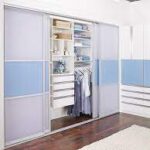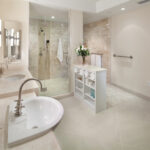The pursuit of beauty and the pursuit of functionality are two intertwined goals in modern landscape design. While the goal of aesthetics is to create visually appealing outdoor spaces, functionality is concerned with practicality and usability. Achieving a harmonious and sustainable landscape that enhances both the visual appeal and the utility of outdoor spaces requires striking the right balance between these two aspects. In this blog, we will discuss the importance of balancing aesthetics and functionality in modern landscape design, demonstrating how this balance can result in breathtaking and functional outdoor environments.
Modern Landscape Design Aesthetics
Aesthetics are extremely important in modern landscape design. A well-designed and visually appealing landscape can improve moods, inspire creativity, and promote well-being. Here are some key aesthetic elements in modern landscape design:
1. Plant Selection: Plant selection, including color, shape, and arrangement, is the foundation of landscape aesthetics. To create eye-catching contrasts and focal points, modern designs frequently incorporate a mix of native and exotic plants.
2. Hardscape Materials: The materials used for pathways, patios, decks, and other hardscape features are an important aesthetic decision. To achieve a contemporary look, modern landscapes frequently use materials such as natural stone, concrete pavers, and composite decking.
3. Focal Points and Features: Aesthetically pleasing landscapes include focal points such as water features, sculptures, fire pits, or unique architectural elements. These elements not only add visual interest, but also provide gathering spaces and opportunities for relaxation.
4. Color Schemes: Color schemes in plantings and hardscapes can elicit specific moods and aesthetics. Modern landscapes frequently use minimalist color palettes, such as whites, grays, and neutrals, to achieve a clean and sophisticated appearance.
5. Balance and Symmetry: Designing with balance and symmetry creates a sense of order and tranquillity. To achieve a harmonious visual balance, modern landscapes frequently use symmetrical layouts and well-proportioned elements.
Modern Landscape Design’s Functionality
In modern landscape design, functionality is just as important as aesthetics. A landscape that does not serve its purpose may be visually appealing but ultimately falls short of its potential. Here are some examples of modern landscape design functionality:
1. Outdoor Usable Spaces: Modern landscapes are intended to be used and enjoyed. To be functional, spaces must be comfortable for relaxation, dining, entertaining, and a variety of outdoor activities.
2. Accessibility and Flow: A functional landscape should be simple to navigate, with clear paths and walkways connecting different areas. People of all ages and abilities require accessibility.
3. Environmental Sustainability: Modern landscape design frequently incorporates sustainable practices, such as the use of native plants, the use of less water, and the use of eco-friendly materials. Sustainability benefits not only the environment but also lowers long-term maintenance costs.
4. Privacy and Security: Privacy and security are essential functional elements in landscape design. To create a safe and secluded outdoor environment, use fencing, strategic plantings, or privacy screens.
5. Irrigation and Drainage: Proper water management, including proper drainage and irrigation systems, is critical for maintaining a functional landscape. It keeps waterlogged areas from forming and keeps plantings healthy.
The Balance of Aesthetics and Functionality
In modern landscape design, striking the perfect balance between aesthetics and functionality is both an art and a science. Here are some strategies and principles to help guide you through the process:
1. Clear Objectives: Begin by defining your objectives and priorities. Determine how you intend to use the outdoor space and your aesthetic preferences. The design process will be guided by clear objectives.
2. Site Analysis: Conduct a thorough examination of the site, taking into account factors such as climate, soil conditions, sunlight, and existing vegetation. This analysis will help to guide plant selection, hardscape selection, and design layouts.
3. Design Harmony: Aim for design harmony by ensuring that functional elements blend seamlessly with the overall aesthetic. A well-designed seating area, for example, can be both comfortable and visually appealing.
4. Practicality: Priority should be given to practicality and usability. Make sure the walkways are wide enough for easy movement, the seating is comfortable, and the outdoor kitchens or dining areas are functional for the intended purpose.
5. Sustainable Design Practices: Include sustainable design practices in your landscape design. Water-efficient irrigation systems, drought-tolerant plants, and permeable hardscape materials are examples of this.
6. Zoning: Divide the outdoor space into functional zones. Make separate areas for rest, dining, gardening, and play. Each zone should fulfill its function while also contributing to the overall aesthetic.
7. Planting Design: Select and arrange plants with care to achieve the desired visual impact. To create dynamic and aesthetically pleasing plant compositions, consider texture, height, and color.
8. Flexibility: Design with this in mind. Allow for adaptable spaces that can change in response to changing needs and preferences. Modular furniture, movable planters, and adjustable lighting can all help to increase flexibility. For expert guidance on creating flexible outdoor spaces that cater to your unique requirements, visit https://deeterlandscape.com/ and explore how they can assist you in designing versatile and functional landscapes.
Case Studies: Aesthetics and Functionality in Design
Let’s look at two examples of successful balancing of aesthetics and functionality in modern landscape design:
Case 1: Urban Rooftop Garden
The client asked for a lush rooftop garden in a densely populated urban area.
- Aesthetics: The design used a wide variety of plants to create a vibrant and visually appealing green oasis. Vertical gardens and colorful planters added depth to the design.
- Functionality: To maximize space, the rooftop garden included comfortable seating areas, a fire pit, and a dining area. Drip irrigation and efficient drainage systems maintained plant health while reducing water waste.
Case 2: A Family-Friendly Backyard
The challenge was to design an outdoor space that would appeal to both children and adults.
- Aesthetics: To create an inviting atmosphere, the design used a combination of plantings and vibrant colors. A pergola with climbing vines and a custom-designed play area were among the focal points.
- Functionality: There was a designated play area with age-appropriate play structures, safety surfacing, and a fenced-in pool in the backyard. Adults were able to relax while keeping an eye on their children thanks to comfortable seating and outdoor dining areas.
Conclusion
In modern landscape design, balancing aesthetics and functionality is a dynamic process that requires careful planning, creative design, and practical implementation. Attaining this balance results in outdoor spaces that are not only visually appealing, but also highly functional and sustainable. Whether you’re transforming a rooftop garden in the middle of a busy city or designing a family-friendly backyard, integrating aesthetics and functionality improves the quality of outdoor living and contributes to the overall well-being of those who enjoy these thoughtfully designed landscapes. The artful fusion of beauty and purpose is the hallmark of exceptional landscape design in today’s world, where outdoor spaces are increasingly valued as extensions of our living environments. To delve deeper into the world of modern landscape design and discover innovative solutions, learn more here about the expertise and services available to you.





